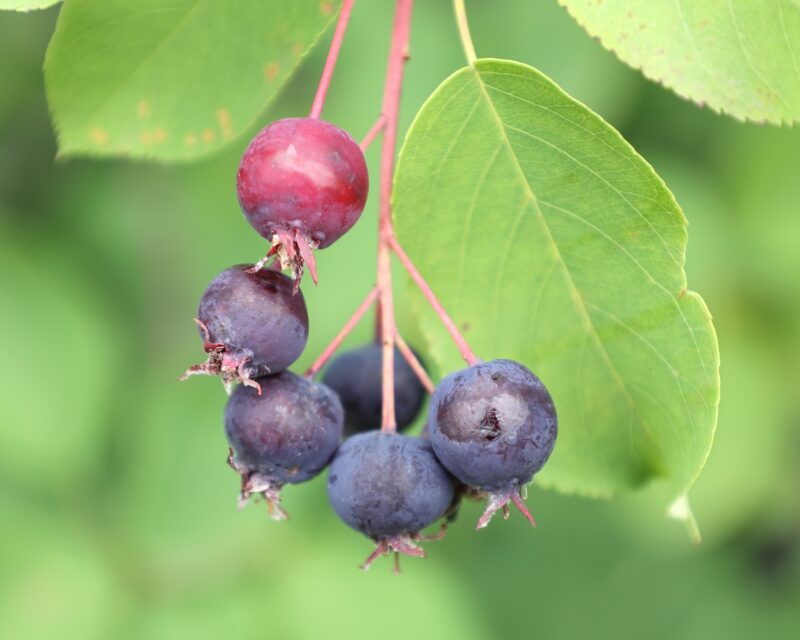
Our backyards can be more than just lawns and flower beds — they can be thriving ecosystems that support birds, insects and even humans. Over the last 50 years, North America has lost nearly 3 billion birds, which is about one out of every four. One of the main reasons? Habitat loss. Without the native plants they depend on for food and shelter, birds and insects struggle to survive.
Birds do more than fill our mornings with song. They eat mosquitoes and other pests that damage gardens and spread disease. Insects, too, play a crucial role. They are food for birds, fish, amphibians, reptiles and bats. They also pollinate plants, recycle nutrients, and aerate the soil. Planting native trees, shrubs, and vines helps rebuild the food web that supports all these creatures. The best part? Some of these plants also produce food for us!
By adding edible native trees, shrubs and vines to our yards, we create a landscape that benefits wildlife while also giving us delicious fruits and nuts. Harvesting them is a great way to teach children about nature and foraging, making the outdoors an exciting and educational space.
Native Trees
Provide food and shelter for countless birds and insects while also offering edible treats for humans. Black cherry (Prunus serotina, produces small black fruits that birds love, and when fully ripe, they’re safe for us to eat too. Red mulberry (Morus rubra), which thrives in both sun and partial shade, also offers juicy berries enjoyed by both birds and humans. The heartier shagbark hickory (Carya ovata) provides nutritious hickory nuts that, while tough to crack, are a rewarding wild snack. The native fruit tree, American plum (Prunus americana) produces small, tart plums that are perfect for jams while also serving as an important food source for birds and pollinators.
Shrubs
Shrubs are just as valuable, offering food at different times of the year and attracting a variety of wildlife. Serviceberry (Amelanchier canadensis) produces early spring berries that taste like blueberries and are just as appealing to birds as they are to us. Black chokeberry (Aronia melanocarpa) may have a tart taste, but it’s packed with antioxidants and is great for making jams or syrups — while also providing an important late-season food source for birds. American hazelnut (Corylus americana) yields edible nuts that attract birds, squirrels, and other wildlife. Northern bayberry (Morella pensylvanica) is an excellent option for cooking — its leaves are used as a seasoning similar to bay leaves, and its waxy berries are a winter food source for birds.
Vines
Vines add another layer of habitat, climbing along fences, trellises, or trees while offering edible rewards. Wild grape (Vitis riparia) is a fantastic native option, producing small, tart grapes that can be made into juice or jelly, while also being a favorite of birds. Passionflower (Passiflora incarnata), with its stunning flowers that attract pollinators, bears a unique fruit known as maypop, which has a tropical-like flavor when ripe. Groundnut (Apios americana) is a climbing vine that thrives in part shade and produces edible tubers that were once a staple food for Indigenous communities. These vines not only provide food but also serve as important shelter and nesting sites for insects and birds.
When planting trees, shrubs, or vines, it’s important to consider their growing conditions — some prefer full sun, while others thrive in part shade. And because deer are common in our region, protecting young plants with tree tubes or fencing is essential until they reach a size where they can withstand browsing.
By choosing native plants, we bring life back to our yards. We give birds and insects the habitat they need while enjoying the beauty and bounty of nature. Let’s rethink our landscapes — not just for us, but for the creatures that share them.
Ruth Ann Rosenthal is a member of the Westhampton Garden Club Conservation Committee.
A Fun Recipe: Wild Grape Jelly
Wild grapes ripen in late summer and early fall. They are tart but make a delicious jelly. Here’s a simple recipe to try with kids.
Ingredients:
• 4 cups wild grapes, rinsed
• 3 cups water
• 3 cups sugar
• 1 packet (1.75 oz.) pectin
Instructions:
Enjoy on toast or mixed into yogurt!